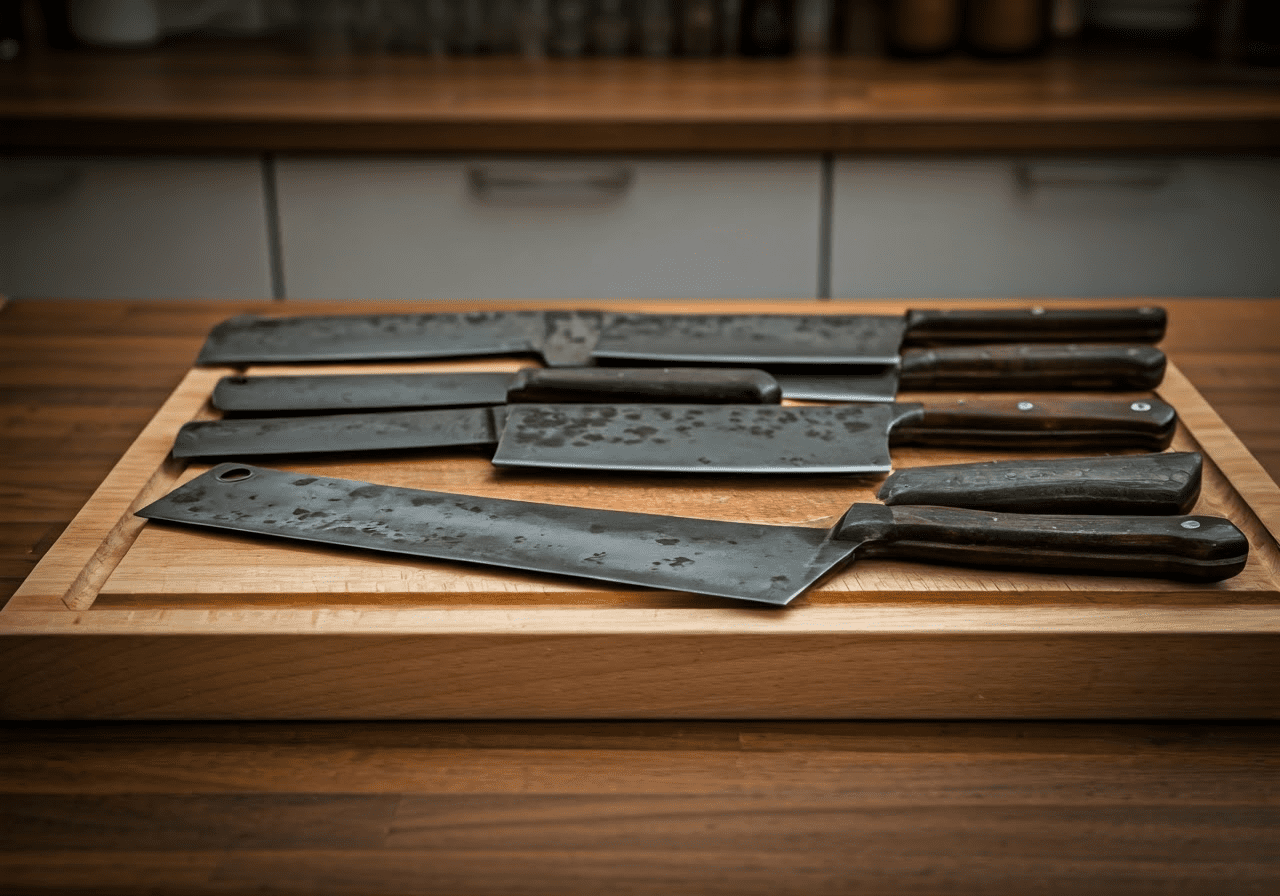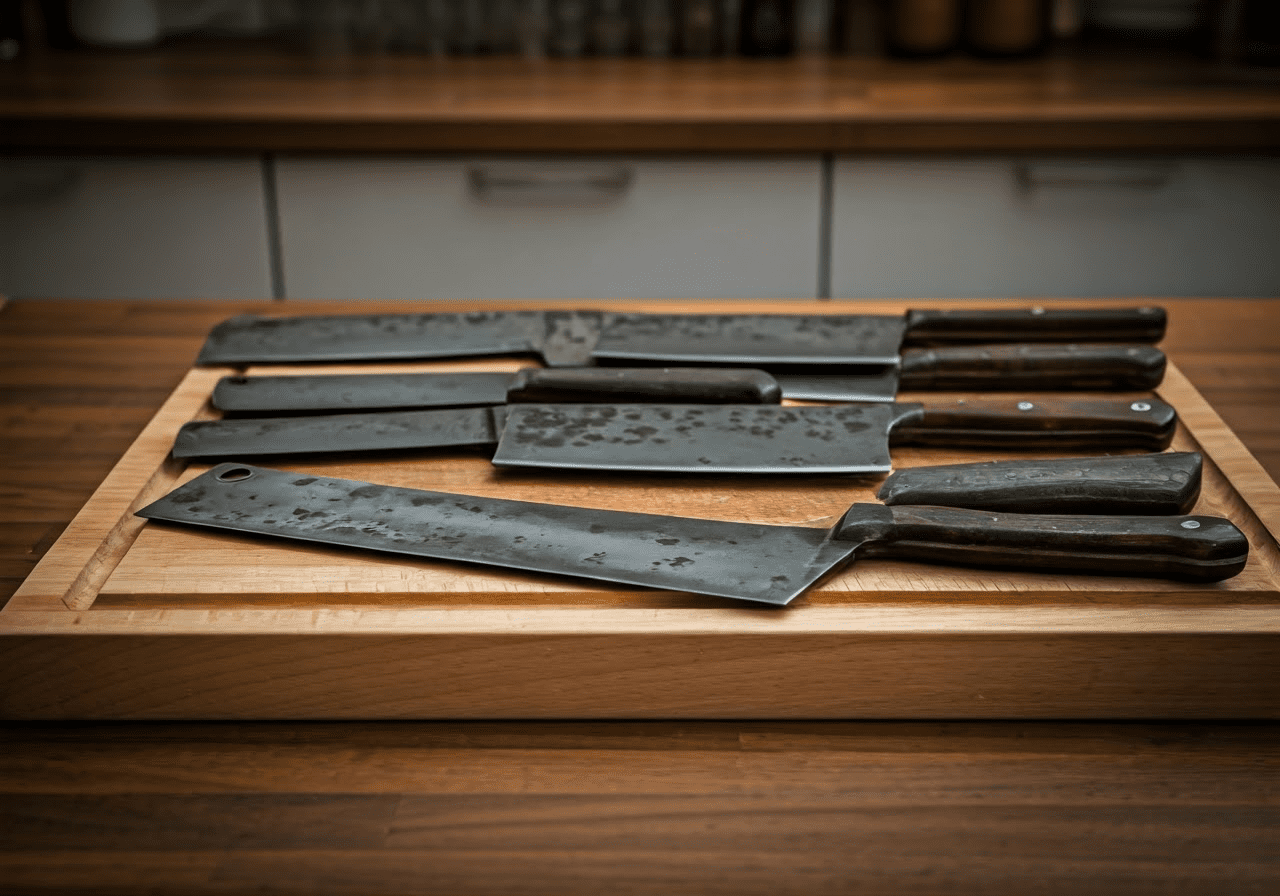
Table of Contents
Key Highlights
- Specific Design: The distinct curved blade of a butcher knife is engineered for a singular purpose: the efficient breakdown of large cuts of meat.
- Superior for Meat: While a chef’s knife can handle some meat cutting, a butcher knife surpasses it in tackling tough tasks like dealing with bone and cartilage.
- Variety in Sizes: Butcher knives come in a range of sizes, from smaller blades ideal for precise cuts to larger ones designed for portioning substantial pieces of meat.
- Essential for Butchers & Home Cooks: A butcher knife is a staple for professionals who work with meat regularly, and it’s equally valuable for the home cook who prefers preparing their own cuts.
- Beyond the Blade: The design extends to the handle, often crafted for optimal grip to ensure safety and efficiency during use.
Introduction
In the world of kitchen knives, the butcher knife is special because of its bold look and design. This knife is not like regular kitchen knives. It has a specific purpose, which is clear from its shape and edges. A butcher knife is made for handling large pieces of meat. This task makes it different from other knives you may have in your kitchen.
The Evolution of the Butcher Knife

The butcher knife we know today did not just show up suddenly. It has changed over many years due to cooking practices and how butchery has developed. Early knives were probably more basic and improved as people learned about metals and how to make them.
As time passed, there was a demand for better tools to handle bigger and tougher animal bodies. This need led to the creation of the modern butcher knife. Now, it is designed for efficiency and accuracy in preparing meat.
Historical significance and development
The butcher’s knife has a long history connected to butchery, which goes back thousands of years. As societies grew and meat became an important part of the diet, the tools for cutting it improved as well.
In the beginning, the knife was made from simple materials. Over time, these tools got better as technology improved. The first knives were made from stone and bone. As people learned how to work with metal, the butcher’s knife also changed. Stronger and sharper metals made it possible to create better, longer-lasting tools. This changed how meat was prepared and managed.
This change has continued because of need and skill. Today’s butcher knife reflects this journey, showing how food, culture, and tool-making are all linked.
Influence of culinary needs on its design
The design of a butcher knife is closely tied to its specific cooking needs. It must handle large cuts of meat and tackle tougher materials like bones. The curved blade is not just for looks; it helps slice more smoothly, which is important when cutting big pieces of meat.
The length of the blade changes based on its use. A shorter butcher knife gives you better control for detailed tasks. On the other hand, longer knives work better for cutting large primal cuts. This variety in size reflects the many needs of butchery, from delicate jobs to tough ones.
In short, the butcher knife shows how design fits a purpose in cooking. It is a tool shaped over time to meet the needs of both professional chefs and home cooks.
Anatomy of a Butcher Knife

The butcher knife is not just one type of tool. It comes in many forms, each made for different tasks in meat preparation. To really understand a butcher knife, you need to notice these small differences. These variations meet the special needs of butchery.
For example, the cleaver has a heavy blade for strong cutting. On the other hand, the boning knife is thin and made for precise work. Each kind of butcher knife has specific features that connect with what it needs to do.
Unique blade shape and its purpose
A butcher knife is easy to recognize because of its unique shape. Its long, wide, and curved blade is made to break down large cuts of meat effectively. This curved blade is practical. It helps you use a rocking motion, which is important for cutting thick pieces of meat smoothly and evenly.
Unlike a chef’s knife, which has a straight edge and is better for pushing and pulling cuts, the butcher knife allows for a smoother, saw-like action. This makes cutting easier and gives you better control. This design is important for jobs like breaking down poultry, cutting large roasts, or trimming extra fat.
Overall, the butcher knife is made for strength and accuracy. It helps you separate joints cleanly, take off bones easily, and create nice-looking cuts of meat.
Handle design for optimal grip
The handle of a butcher knife is important. It is made to give a good grip, keeping safety and efficiency in mind. Professional chefs know how much a good handle matters since they use these knives for long periods.
A secure grip helps them control the blade better, which is key when butchering. This is important, especially with tougher cuts of meat that need extra pressure to cut.
Handles are often made from strong, moisture-resistant materials like wood or synthetic composites. They are shaped to fit comfortably in the hand. Some handles have textured surfaces or grooves for fingers, helping to improve grip and reduce hand fatigue. This shows the careful design for tools made for professionals and cooking fans.
Comparing Butcher Knives with Other Kitchen Knives
The butcher knife is important in the group of kitchen knives. It is similar to other knives, like the chef’s knife, but they also have key differences. These differences mostly show in their size, shape, and what they are for.
Knowing these differences helps you pick the right knife for what you need to do in cooking. For example, a butcher knife is not good for delicate slicing jobs. Those are better for a paring knife. On the other hand, a paring knife can’t handle cutting up a large roast like a butcher knife can.
Butcher knife vs. Chef’s knife: Understanding the difference
Both the butcher knife and the chef’s knife are very important tools in a good kitchen. They look different and serve different uses. The chef’s knife is often seen as the main tool. It can do many tasks, like chopping vegetables or slicing meat.
The butcher knife is made for butchering. It has a longer and wider curved blade. This makes it great for breaking down large cuts of meat. Tasks like this can be hard, or even impossible, for a chef’s knife.
Choosing between a butcher knife and a chef’s knife depends on what you need to do. For regular chopping, slicing, and dicing, the chef’s knife is the best. But for tasks like processing a whole chicken or cutting a large piece of meat, the butcher knife is the best tool to use.
Why cleavers are not the same as butcher knives
While we often call them “butcher’s tools,” cleavers and butcher knives are different. Each has its own special features for specific meat preparation tasks.
The cleaver has a thick and heavy blade. It is usually rectangular in shape. This design helps it perform tasks that require a lot of force. It can cut through bone and cartilage easily. This makes it great for separating large joints.
A butcher knife, especially those with curved blades, is made for slicing and trimming bigger cuts of meat. Its thinner blade and curved shape allow for smoother and more controlled cuts. This makes it perfect for skinning, deboning, and portioning meat.
In the end, mixing up these two tools is like using a hammer to drive a screw. They both have their place in a well-stocked toolbox. Knowing what each tool does best helps you work safer and more efficiently.
Why do butcher knives have a hole in the blade?
You may have seen that some butcher knives, especially those with curved blades, have holes near the bottom of the blade. These holes are known as “Granton edges.” They are not just for looks; they have a real use. The holes create air pockets between the blade and the meat, which helps reduce friction and stop sticking.
This feature is very helpful when slicing thin or soft cuts of meat. It helps prevent tearing and makes the slices look nicer. The holes also make cleaning easier since they allow food bits and juices to come out more easily.
Why are butcher knives so sharp?
The sharpness of a butcher knife is very important. It helps the knife do its job well and safely. A sharp blade needs less strength to cut through meat. This leads to cleaner cuts and less chance of slipping. This is especially important for tough cuts of meat, bone, and cartilage. Using a dull knife here can require too much force, which can cause accidents.
Also, a sharp butcher knife allows for precise cuts. This precision is vital when deboning poultry, removing silverskin from roasts, or cutting meat into specific weights. In the end, a sharp butcher knife gives better control, increases safety, and leads to better results in the kitchen.
What is the purpose of the small curved knife?
Within a set of butcher knives, you may find a smaller curved knife called a boning knife. This knife is made to separate meat from bone. It does this using precision and control. The curved blade helps users move around bones and joints easily. This means less meat is wasted and the cuts are cleaner.
The small size of the boning knife makes it easy to use in tight spots. It is perfect for tasks like deboning a chicken, taking ribs from a rack of lamb, or filleting fish. Its compact shape and sharp blade help both professional chefs and home cooks tackle these detailed butchering tasks confidently.
Conclusion
In conclusion, the design of a butcher knife has changed over time. It has adjusted to fit cooking needs and help in food preparation. Each part of the knife, from the blade shape to the handle design, has its purpose. This design improves how well and accurately we can do butchering tasks. When you know how a butcher knife works, you see its sharpness and usefulness in the kitchen. So, when you use a butcher knife, think about the care and skill that went into making it. This makes your cooking experience better and more enjoyable.
Frequently Asked Questions
Why do butcher knives have a curved blade?
The curved blade of a butcher knife helps make a rocking motion. This is great for working around bones. It also makes smooth slices through tough cuts of meat.


